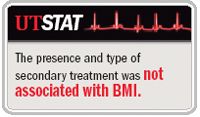Article
Obesity doesn't influence need for secondary prostate cancer treatment
Atlanta-In a recent study of nearly 6,500 men treated for localized pros-tate cancer, researchers found that being obese did not significantly affect the need for secondary treatment, nor did it result in decreased overall or disease-specific survival.
Atlanta-In a recent study of nearly 6,500 men treated for localized pros-tate cancer, researchers found that being obese did not significantly affect the need for secondary treatment, nor did it result in decreased overall or disease-specific survival.

To study whether obesity affected prostate cancer patients' need for secondary treatments or decreased their overall and disease-specific survival, Dr. Ross and colleagues referred to the multi-institutional Cancer of the Prostate Strategic Urologic Research Endeavor (CaPSURE) database.
The researchers identified 6,416 men with clinically localized prostate cancer treated between 1995 and 2005. The database includes body mass index and clinicopathologic disease characteristics. Pa-tients were categorized into four categories: normal (<25 Kg/m2), overweight (25 to 29.9 Kg/m2), obese (30 to 34.9 Kg/m2), and very obese (≥35 Kg/m2). They found that 29% of the study population was classified as having a normal BMI.
The researchers looked for any sort of secondary prostate cancer treatment, in-cluding radiation, cryotherapy, or hormonal therapy, and they used Cox proportional hazards models to evaluate relationships among BMI category, risk category, age at diagnosis, and presence of diabetes with overall and disease-specific survival.
Dr. Ross and his colleagues followed the subjects for a median 36.1 months, which the researcher said gives the study credibility.
"Our follow-up ranged from 0 up to 201 months, with 35% of the patients being followed for at least 5 years," he said. "This is important because, especially with localized prostate cancer, it is going to take a while to notice any difference among patients. This is a disease that, in general, has a slow natural history."
BMI and secondary treatment
According to the study results, there were 529 deaths during the follow-up period, of which 107 (or 20%) were considered due to prostate cancer. Of those who received a secondary form of prostate cancer treatment, 354 patients (10.2%) underwent radical prostatectomy, 85 (9.4%) had brachytherapy, and 197 (25.9%) had external-beam radiation therapy.
The presence and type of secondary treatment was not associated with BMI, the researchers reported.
"This is where the heads will be turning," Dr. Ross said. "There are currently 203 publications on obesity and prostate cancer, and about 95% of those have been written during the last 5 years. Some papers found an association, while others did not."
"There is controversy [about] whether obesity is related to the risk of developing prostate cancer," added Christopher Kane, MD, the study's senior author, "but strong evidence that obesity is related to recurrence after surgery from CaPSURE and other sources. It is therefore reassuring that this study did not find an association between obesity and overall or disease-specific survival."
The researchers' multivariate analysis found that patients with high-risk disease were 2.7 times more likely to have de-creased overall survival. Men with intermediate-risk disease were 1.6 times more likely, and those who had diabetes were 1.78 times more likely to have decreased overall survival. The same factors were predictive of decreased disease-specific survival in multivariate analysis. High-risk disease was associated with 11.7 times the risk, intermediate-risk disease with 2.53 times the risk, and diabetes with 1.7 times the risk.
















